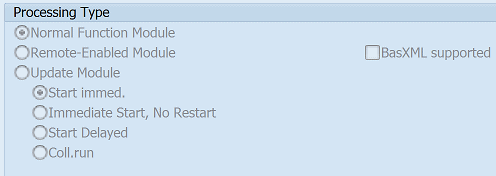SAP CX_PDM_SHOW_OBJECTS_FROM_STACK Function Module for NOTRANSL: Klasse, Klassenart oder Merkmal vom Stack lesen
CX_PDM_SHOW_OBJECTS_FROM_STACK is a standard cx pdm show objects from stack SAP function module available within SAP R/3 or S/4 Hana systems, depending on your version and release level. It is used for NOTRANSL: Klasse, Klassenart oder Merkmal vom Stack lesen processing and below is the pattern details for this FM, showing its interface including any import and export parameters, exceptions etc. there is also a full "cut and paste" ABAP pattern code example, along with implementation ABAP coding, documentation and contribution comments specific to this or related objects.
See here to view full function module documentation and code listing for cx pdm show objects from stack FM, simply by entering the name CX_PDM_SHOW_OBJECTS_FROM_STACK into the relevant SAP transaction such as SE37 or SE38.
Function Group: CLEX_PDM
Program Name: SAPLCLEX_PDM
Main Program:
Appliation area:
Release date: N/A
Mode(Normal, Remote etc): Normal Function Module
Update:

Function CX_PDM_SHOW_OBJECTS_FROM_STACK pattern details
In-order to call this FM within your sap programs, simply using the below ABAP pattern details to trigger the function call...or see the full ABAP code listing at the end of this article. You can simply cut and paste this code into your ABAP progrom as it is, including variable declarations.CALL FUNCTION 'CX_PDM_SHOW_OBJECTS_FROM_STACK'"NOTRANSL: Klasse, Klassenart oder Merkmal vom Stack lesen.
EXPORTING
P_OBJTYP = "Character Field Length = 10
IMPORTING
P_CLASS = "Class Number
P_KLART = "Class Type
P_ATNAM = "Characteristic Name
EXCEPTIONS
OBJEKTTYP_NOT_FOUND = 1
IMPORTING Parameters details for CX_PDM_SHOW_OBJECTS_FROM_STACK
P_OBJTYP - Character Field Length = 10
Data type: CHAR10Optional: No
Call by Reference: Yes
EXPORTING Parameters details for CX_PDM_SHOW_OBJECTS_FROM_STACK
P_CLASS - Class Number
Data type: KLAH-CLASSOptional: No
Call by Reference: Yes
P_KLART - Class Type
Data type: TCLA-KLARTOptional: No
Call by Reference: Yes
P_ATNAM - Characteristic Name
Data type: RCTAV-ATNAMOptional: No
Call by Reference: Yes
EXCEPTIONS details
OBJEKTTYP_NOT_FOUND - DE-EN-LANG-SWITCH-NO-TRANSLATION
Data type:Optional: No
Call by Reference: Yes
Copy and paste ABAP code example for CX_PDM_SHOW_OBJECTS_FROM_STACK Function Module
The ABAP code below is a full code listing to execute function module POPUP_TO_CONFIRM including all data declarations. The code uses the original data declarations rather than the latest in-line data DECLARATION SYNTAX but I have included an ABAP code snippet at the end to show how declarations would look using the newer method of declaring data variables on the fly. This will allow you to compare and fully understand the new inline method. Please note some of the newer syntax such as the @DATA is not available until a later 4.70 service pack (SP8), which i why i have stuck to the origianl for this example.| DATA: | ||||
| lv_p_class | TYPE KLAH-CLASS, " | |||
| lv_p_objtyp | TYPE CHAR10, " | |||
| lv_objekttyp_not_found | TYPE CHAR10, " | |||
| lv_p_klart | TYPE TCLA-KLART, " | |||
| lv_p_atnam | TYPE RCTAV-ATNAM. " |
| CALL FUNCTION 'CX_PDM_SHOW_OBJECTS_FROM_STACK' "NOTRANSL: Klasse, Klassenart oder Merkmal vom Stack lesen |
| EXPORTING | ||
| P_OBJTYP | = lv_p_objtyp | |
| IMPORTING | ||
| P_CLASS | = lv_p_class | |
| P_KLART | = lv_p_klart | |
| P_ATNAM | = lv_p_atnam | |
| EXCEPTIONS | ||
| OBJEKTTYP_NOT_FOUND = 1 | ||
| . " CX_PDM_SHOW_OBJECTS_FROM_STACK | ||
ABAP code using 7.40 inline data declarations to call FM CX_PDM_SHOW_OBJECTS_FROM_STACK
The below ABAP code uses the newer in-line data declarations. This allows you to see the coding differences/benefits of the later inline syntax. Please note some of the newer syntax below, such as the @DATA is not available until 4.70 EHP 8.| "SELECT single CLASS FROM KLAH INTO @DATA(ld_p_class). | ||||
| "SELECT single KLART FROM TCLA INTO @DATA(ld_p_klart). | ||||
| "SELECT single ATNAM FROM RCTAV INTO @DATA(ld_p_atnam). | ||||
Search for further information about these or an SAP related objects